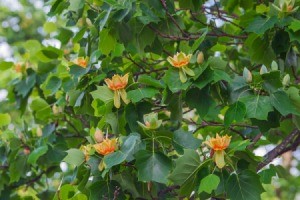
Hardiness Zone: 7a
Sassy from Trilla, IL
Sassy,
Your friend's tulip tree has an aphid problem, which is typical for this type of tree. Tulip trees are lovely to look at, but famous for developing "aphid drip." The "sprinkles of rain" you're seeing is actually the tree dripping honeydew; a sticky substance secreted by the aphids as they suck the sap from the tree's leaves and flowers. If you touch some of the grass under your friend's tree, you'll probably find that it's sticky. Honeydew can make a real mess, especially on roofs, outdoor furniture and your car.
Aphids can complete several life cycles in a season so the drips probably start about the time populations are at their peak. If her tree is large, it probably won't suffer serious damage from the aphids, but it will suffer a loss of vigor as a result of losing sap. The problem is that aphid honeydew attracts sooty mold, which can spread to other plants and trees.
Unfortunately, controlling aphids on these types of trees can be difficult and how your friend tackles the problem will depend on how big her tree is. A lot can be accomplished just by spraying the tree down regularly with a forceful stream of water from the garden hose. Since this sounds like it's an ongoing problem, she may want to seek a combination of biological and chemical controls. Releasing ladybug beetles, pirate bugs or parasitic wasps will all help control populations. She may also want to consider spraying her tree with any one of a number of organic insectidal soaps.
Ellen
This is not water - the tree is infested with aphids.
Use a systemic insectacide once a year (buy at Lowe's). You simply pour it on the ground around the tree and it is absorbed by the roots into the tree - then - no aphids and no "rain".